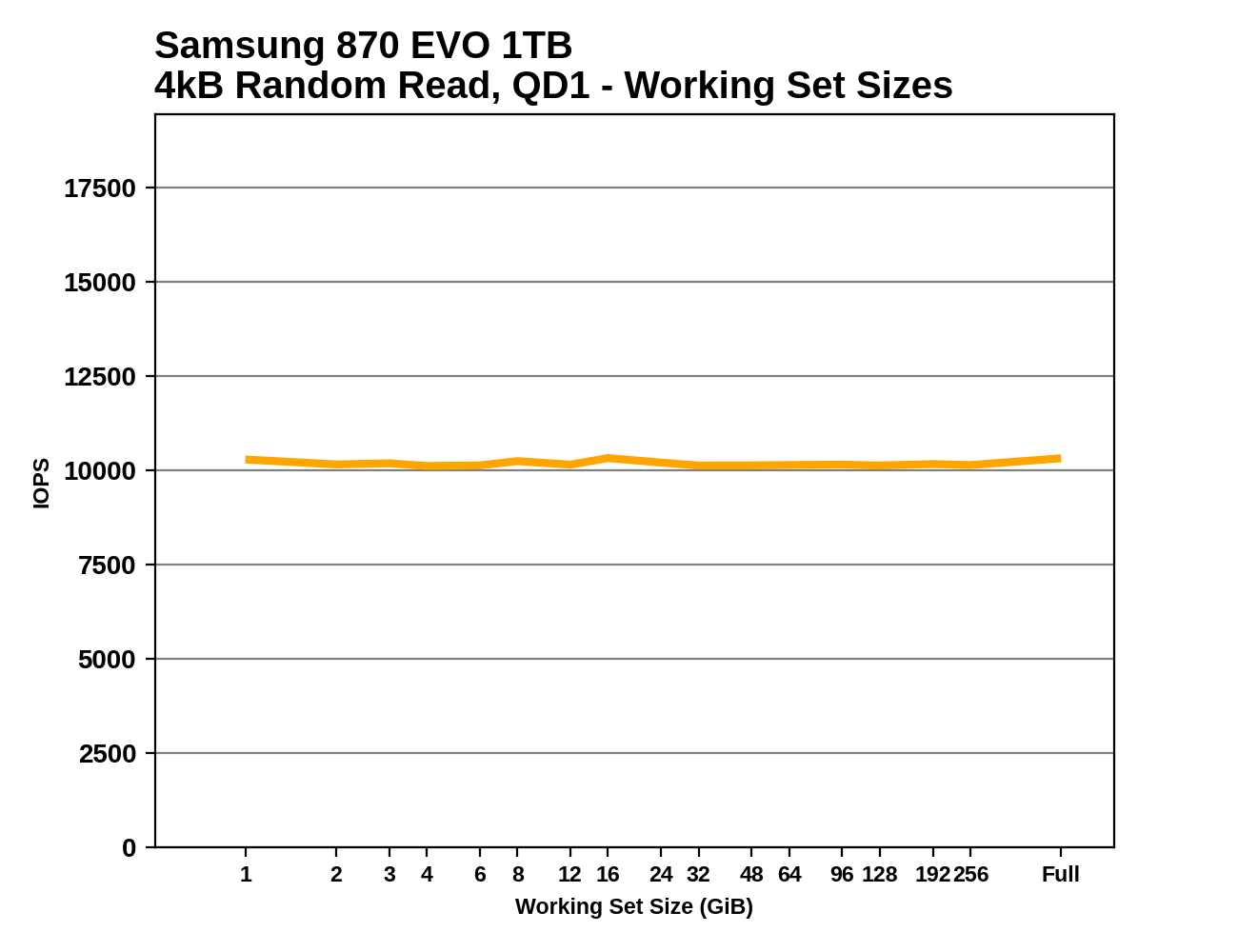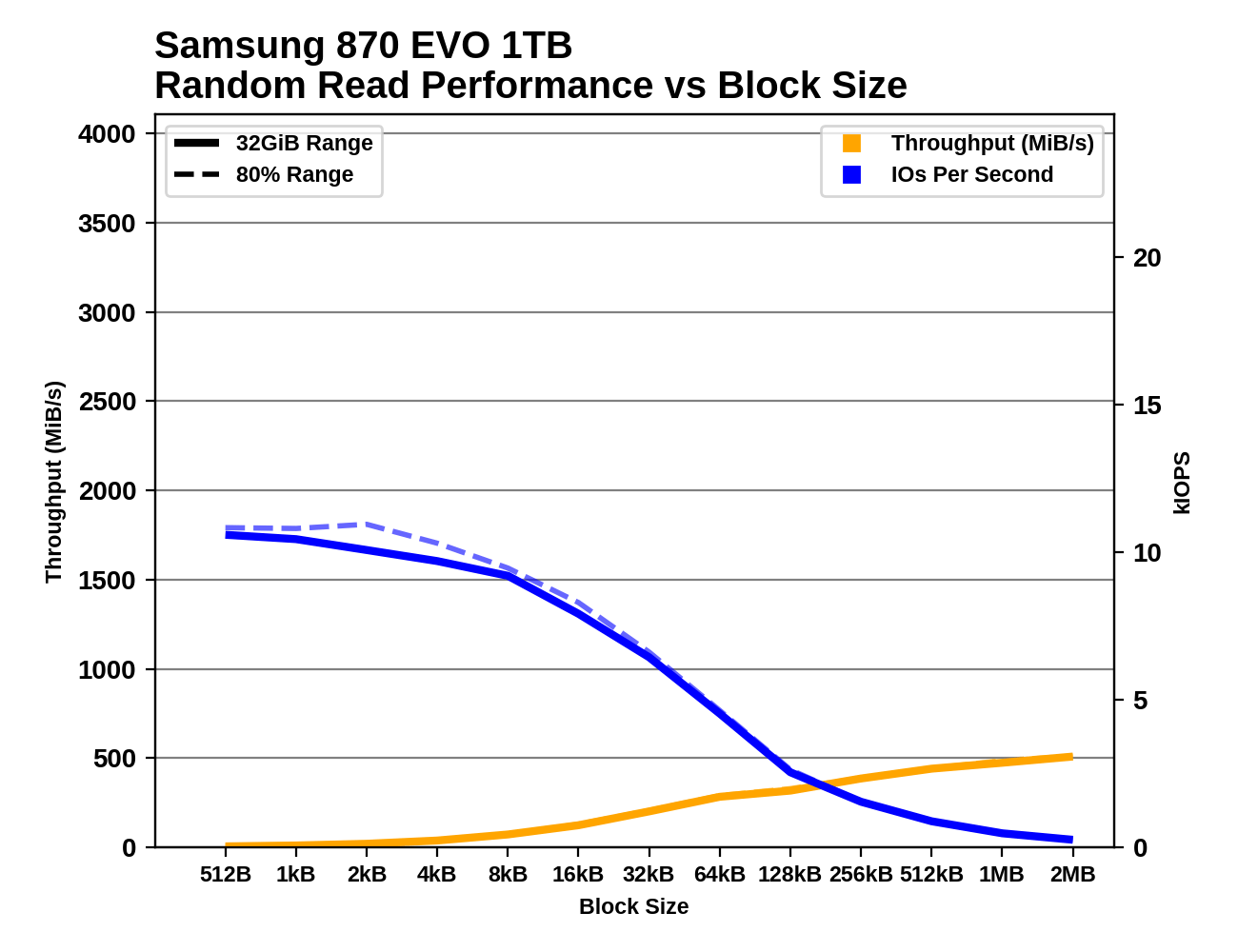The Samsung 870 EVO (1TB & 4TB) Review: Does the World Need Premium SATA SSDs?
by Billy Tallis on February 17, 2021 8:00 AM ESTAdvanced Synthetic Tests
Our benchmark suite includes a variety of tests that are less about replicating any real-world IO patterns, and more about exposing the inner workings of a drive with narrowly-focused tests. Many of these tests will show exaggerated differences between drives, and for the most part that should not be taken as a sign that one drive will be drastically faster for real-world usage. These tests are about satisfying curiosity, and are not good measures of overall drive performance. For more details, please see the overview of our 2021 Consumer SSD Benchmark Suite.
Whole-Drive Sequential Fill
 |
|||||||||
| Pass 1 | |||||||||
| Pass 2 | |||||||||
Some of our other tests have shown a few signs that the 870 EVO's write performance can drop when the SLC cache runs out, but this straightforward sequential write pass over the entire drive doesn't reveal any such behavior. The 870 EVO's sequential write performance is extremely consistent, even on the second write pass.
 |
|||||||||
| Average Throughput for last 16 GB | Overall Average Throughput | ||||||||
Due to the excellent performance consistency, the Samsung 870 EVOs edge out the other SATA drives with marginally higher average sequential write speeds. The entry-level NVMe drives end up much worse off than the mainstream SATA drives once their caches run out, but the more mainstream NVMe drive blows them all away.
Working Set Size
 |
|||||||||
As expected, the Samsung 870 EVO's random read performance shows basically no variation across a range of working set sizes, and that read performance is at least a little bit faster than any of the other SATA drives or the entry-level NVMe drives.
Performance vs Block Sizes
 |
|||||||||
| Random Read | |||||||||
| Random Write | |||||||||
| Sequential Read | |||||||||
| Sequential Write | |||||||||
There are no particular surprises in how the Samsung 870 EVO handles IOs of different block sizes. Unlike some drives, it has no trouble with sub-4kB IOs. It offers moderate improvements over the 860 EVO for mid-sized random reads (up to about 128kB). The one negative is that for writes we again see more inconsistency from the 870 EVO than the 860 EVO when testing an 80% full drive. The simple whole-drive sequential write test may not have been able to reveal any SLC caching troubles, but it does seem clear that the caching behavior has some performance regressions for more complicated workloads on a drive that's more well-used—though it's still unlikely to matter for any typical real-world consumer workload.










136 Comments
View All Comments
Billy Tallis - Thursday, February 18, 2021 - link
I still occasionally use SATA SSDs as if they were floppies, since all of my desktops have hot-swap bays. But its becoming more common that I use M.2 NVMe SSDs in USB enclosures. Either solution is preferable to WiFi or gigE when transferring tens of GB or more.Kamen Rider Blade - Thursday, February 18, 2021 - link
Not every machine is going to be connected locally on your own network.Not every machine will even be online either.
Please don't comment for the rest of us.
Spunjji - Friday, February 19, 2021 - link
M.2 in a USB 3.2 / Thunderbolt caddySorted
CaptainChaos - Wednesday, February 17, 2021 - link
How many grannies or grandpas need more than what SATA offers in the machines they use to go online for email, Facebook, or Amazon? Even if they stream videos their systems are ok using hardware a couple steps behind state of the art! SATA will linger for several more years.Oxford Guy - Friday, February 19, 2021 - link
640K ought to be enough for anyone.lmcd - Wednesday, February 17, 2021 - link
The thing that gets me is that just because a drive is U.2 doesn't mean it has to be a full 2.5in drive. Could easily do a "half size" or some random thing.Silver5urfer - Wednesday, February 17, 2021 - link
Yes the world needs a SATA SSD lol.NVMe drives are tooo damn hot. I don't know how long they will run like that, I've been running SATA without any ventilation on my notebook machine and use MLC drive for games and it's fantastic. Reliable doesn't overheat or has BS driver things esp for Win7 or such.
I thank Samsung for at-least doing this, I hope they put out a damn MLC with 4TB as well and do an 8TB 870 EVO update. As for SATA it's a reliable technology and has numerous advantages over the stupid PCIe lane limit, bandwidth, heat, dependable TBW.
lmcd - Wednesday, February 17, 2021 - link
There's a reason people are going wild over the SK Hynix P31. It's exactly what you need.Danvelopment - Wednesday, February 17, 2021 - link
SATA drives totally still make sense.Why?
Because there's only so much space on a motherboard, and every m.2 drive takes up quite a bit of it.
SATA allows you to redistribute drives within the case.
Maybe once hard drives are gone, then a new form factor can come out, 1" SATA or something. But cases will still be made with HDD form factors until they disappear, so might as well stick to that standard.
But they should do something about IOPS, design a drive destined to be SATA, with a controller that can knock out the full 600MBps with any load pattern, dump three or four times as many channels on it as an m.2, and they'll fly off the shelves.
Gigaplex - Wednesday, February 17, 2021 - link
Then you should be using U.2 instead of M.2.